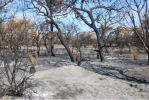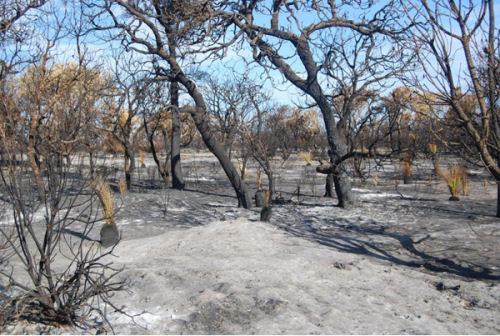 Two weeks ago fire 40 km north east of Perth burnt for 10 days and blazed through some 7,000 hectares of land, burning homes - far too many to count, or for that matter, to contemplate. It impacted on countless species and would have burnt millions of individuals, all of whom, like us, are categorised biologically under the heading Kingdom of Animalia. But that's not how the newspapers reported it...
Two weeks ago fire 40 km north east of Perth burnt for 10 days and blazed through some 7,000 hectares of land, burning homes - far too many to count, or for that matter, to contemplate. It impacted on countless species and would have burnt millions of individuals, all of whom, like us, are categorised biologically under the heading Kingdom of Animalia. But that's not how the newspapers reported it...
 “The fire destroyed two derelict houses and three sheds”...
“The fire destroyed two derelict houses and three sheds”...
This statement pretty well sums up the sort of media reporting that a fire, regardless of size or location, generally generates.
Human life, infrastructure, and on a good day, human “property” such as livestock and pets… but wild life rarely, if ever, cracks a mention!
Yet when a fire, which basically burnt for 10 days, blazed through some 7,000 hectares of land 40 km north east of Perth two weeks ago, it DID burn more than human infrastructure – it burnt homes - far too many to count, or for that matter, to contemplate. It impacted on countless species and would have burnt millions of individuals, all of whom, like us, are categorised biologically under the heading Kingdom of Animalia.
Why the silence? Why not an uproar, collective grieving, and hostility towards its maker?
It’s a question I’ve asked myself over, and over, and over again. About this fire, and the many others before, be they, by design, “prescribed”, “illegal arson” or “accidental.”
But then there is that prevailing assumption, isn’t there, especially when we talk about bushfires.
No one else lives there.
With a mind set like this you can do what you like with the land – the rape, pillage and plunder story that took off in style when our forebears first came to this country and has continued ever since.
Or maybe it’s our superiority complex – the lesser being story that enables humans to categorise wild life as pests, vermin, resources, or as simply irrelevant or expendable in our version of the grand scheme of things.
And then there is the whole burning thing – you know the one – the Aboriginal burning; the need to protect human life, property and infrastructure; reduce fire risk that derives itself from climate change; and of course burning regimes that are for good, or even necessary, for nature conservation and biodiversity.
Little wonder that with this sort of propaganda few, if any, question fire events - unless of course they are personally affected by them.
After all, no-one wants to die, or see their loved ones die – nor do they want to see their homes destroyed, or their livelihoods taken from them.
Same goes for other species, actually, but really, who cares about that?
It is my contention that until such time as the status of wild life elevates way up to where it should be the majority of the population will continue to regard fire, and the repercussions thereof, in this limited, anthropocentric way.
It IS alarming that 1839 bushfires in the last 6 weeks have been reported in WA. What IS more alarming is that these figures, apparently, are not unusual.
Clearly we have a problem… one that is not confined to WA.
507 of these fires have been deemed suspicious or found to be deliberately lit, according to a Department of Fire and Emergency Services (DFES) spokesman.
Ouch!
And one is left to wonder how many more fires are deemed “accidental” - like the most recent one (of course there have been others) that razed through Bullsbook after sparks from an angle grinder left residents unable to see, breathe, and desperately trying to drive out, through fire.
If it was bad for them, imagine if you will, the impact on penned domestic animals, and wildlife, who were also unable to see, breathe, and were equally desperate to escape the fire.
Whilst it is true that some highly mobile wildlife can flee the initial onslaught of fire, especially if there are no fences in the way, the speed, movement, rapidly increasing and radiant heat, height, and extent of the fire would have decreased opportunities for many species, and severely limited the individual’s chance of survival.
Add to those factors the use of back burning, deliberate burning of unburnt pockets, the use of aerial fire suppressants and later, burning gels...
Still, miracles can happen….
Of the carnage, Mallubillai Wildlife Rehabilitator Lyn Manuel said,
“We have two little joeys being treated for bad burns.. but there are no words to describe what we see. The smell of death is everywhere…”
Two weeks after the event an eerie silence is broken only by a wind that knows no barriers. Tree skeletons abound, the soil is scorched, naked and warm to the touch. There are some, not many, tracks to be seen, but even then there are those that tell an all too familiar sad story.
There is no shortage of white ash piles – the intensity of the fire enough to burn bones.
It’s ugly, and I’m angry.
The fire did NOT just destroy two derelict houses and three sheds!
I’m sorry, but the fact that the local resident who started this particular fire is apparently remorseful doesn’t cut it, as far as I’m concerned.
Tell that to the wild life.
Asking people to be more safety conscious when they are operating hot tools or things that generate sparks in the open area, especially when working around dry vegetation is clearly not working now, and never will.
It is my guess though that those in authority know that.
So rather than engage in preventative measures, and place blame, and personal responsibility where it belongs, we are pushed into a model of action and behaviour that has, yet again, significant repercussions for wild life.
The bare earth policy (desertification) - the favoured, politically savvy, mitigation strategy.
No need to for anyone to change their behaviours… well…OK…just don’t use those angle grinders in the open on total fire ban days.
And the war against nature takes on a new dimension - litter becomes fuel, in fact all vegetation becomes fuel, and trees become fire risks that will fall on us, our houses, our sheds, our power poles…and, and ,and.
We can no longer live among the gum trees.
And if that is not bad enough the public clamour for crown land to be decimated in the same way.
They forget.
Someone else lives there.
Fires destroy ecosystems. Fire destroys homes. Fires take lives - millions of them.
The true cost of fire, measured in terms of loss of life, pain and suffering, habitat destruction, environmental degradation, pollution, health impacts…is the real story that needs telling.
Next time you hear that no lives were lost, you too need to do what it takes to set the record straight.
Wild life matters!

Add comment